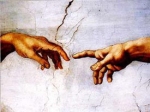Verse: Luke 24:5-6 "Why do you seek the living among the dead? He is not here, but has risen.” ESV
Matthew 28; Mark 16; Luke 24
The day following the first day of the Feast of Unleavened Bread is called “Reshit Katzir” or the
“beginning of the harvest”. This day a sheaf of barley (the first grain crop in Israel) was waved before the
Lord in a prescribed ceremony to mark the counting of the omer which was a 49-day countdown to the
Festival of Shavuot (also called the Feast of Weeks, or Pentecost).
Leviticus 23:9-13
And the Lord spoke to Moses, saying, “Speak to the people of Israel and say to them, When
you come into the land that I give you and reap its harvest, you shall bring the sheaf (omer) of
the first fruits (reshit) of your harvest (katzir) to the priest, and he shall wave the sheaf before
the Lord, so that you may be accepted. On the day after the Sabbath the priest shall wave it.
And on the day when you wave the sheaf, you shall offer a male lamb a year old without
blemish as a burnt offering to the Lord. ESV
This seemingly rather small event points to one of the most pivotal events in the history of mankind.
This day points to and remembers the resurrection of Jesus Christ, our Messiah, the Firstborn of the
Dead!
In the wave offering, the priest would raise the sheaf to the north, south, east and west as a gesture of
dedicating the first part for the whole. Only after this offering could the crop begin to be used (Lev.
23:14).
From: Reshit Katzir – Messiah as the Beginning of the Harvest
HebrewforChristians.com by John Parsons
For the full article go here:
http://www.hebrew4christians.com/Holidays/Spring_Holidays/First_Fruits/first_fruits.html
Chronology of the Death, Burial and Resurrection of Yeshua
Here is a tentative chronology of the key events surrounding Yeshua's death, burial, and resurrection.
Yeshua was crucified on Nisan 14 (a Thursday), exactly when the Passover lambs were being offered at
the Temple, and He rose from the dead three days and nights later, on the night of Nisan 17 (i.e., before
sunrise on Sunday):
- Nisan14 evening - Yeshua's early Seder (Wed. night)
- Nisan14 daytime - "Preparation day" (Luke 23:54; Mark 15:42) for Passover. Yeshua died
Thursday afternoon at the same time that the korban Pesach (Passover Lamb) was sacrificed
at the Temple and was buried before sundown.
- Nisan15 evening - The High Sabbath of Passover begins (the actual Seder night)
- Nisan15 daytime - The High Sabbath of Passover (Friday before sundown)
- Nisan16 evening - The Weekly Sabbath begins (Friday after sundown)
- Nisan16 daytime - Weekly Sabbath, waving of the omer (Saturday)
- Nisan17 evening - Yeshua was resurrected some time before sunrise on Sunday
- Nisan17 daytime - Women bring spices to the tomb early in the morning. Disciples encounter
risen Messiah.
To understand this reckoning, you must remember that a Jewish day starts at sundown and ends at
twilight the following day. If Yeshua was on the cross on Nisan 14 (during the time of sacrifice of korban
Pesach at the Temple) and was raised after three days and nights, we then would have the following:
3 Days and 3 Nights

How to Read this Chart
First it is vital to understand that the Jewish day begins at sundown and ends at twilight the following
day... The chart above therefore indicates the following chronology:
1. Yeshua was crucified and buried on Nisan 14, a Thursday afternoon (i.e., 1/2 day). This was
also the "Preparation Day" for the Sabbath of Passover that would begin after sundown that
same day.
2. He was in the tomb Nisan 15 (from sundown until twilight Fri. = 1 day) and
3. He was in the tomb Nisan 16 (from sundown until twilight Sat. = 1 day) and
4. He was also in the tomb on Nisan 17 (i.e., after sundown Sat. = 1/2 day) BUT
5. He later rose from the dead that day Nisan 17 (i.e., before sunrise Sun. morning)
If you add these up you will get 1/2 + 1 + 1 + 1/2 = 3 days and nights (Matt. 12:40). He therefore was
crucified on Thursday, Nisan 14 (before sundown) and was resurrected on Sunday, Nisan 17 (before
sunrise) on the third day (Luke 24:45-46). The disciples then encountered the risen Lord on Nisan 17, a Sunday morning (Matt. 28:1-10).
It is also important to understand that there are more Sabbaths in the Jewish year than there are "seventh days" on the Jewish calendar. For instance, Passover and the other holidays are regarded as Sabbaths, and therefore in Mark's gospel the women are said to have come to the tomb after the Sabbaths (i.e., σαββάτων, a plural noun) which indicates that both Passover (Nisan 15) and the following day (i.e., Nisan 16, the seventh day of the week) were regarded as Sabbath days (see the Greek text for
Mark 16:2).
1 Corinthians 15:20-25 The Last Enemy Destroyed
But now Christ is risen from the dead, and has become the firstfruits of those who have fallen
asleep. For since by man came death, by Man also came the resurrection of the dead. For as
in Adam all die, even so in Christ all shall be made alive. But each one in his own order: Christ
the firstfruits, afterward those who are Christ's at His coming. Then comes the end, when He
delivers the kingdom to God the Father, when He puts an end to all rule and all authority and
power. NKJV
This is really hard to believe.
1 John 4:2-3
By this you know the Spirit of God: every spirit that confesses that Jesus Christ has come in the
flesh is from God, and every spirit that does not confess Jesus is not from God. ESV
On one occasion, Jesus healed a blind man who was blind from birth by putting mud in his eyes. He did
this on the Sabbath and the leaders accused Him of violating the law (Torah). They also accused the man
of not really being blind in the first place. Jesus did not waiver in His claim and He began to tell them
that He was the good shepherd who lay down His life for the sheep. Furthermore, He claimed He had
authority to lay down His life and to take it up again. In this He predicted His own resurrection. His
words produced arguments, not belief.
John 10:17-21
“For this reason the Father loves me, because I lay down my life that I may take it up again.
No one takes it from me, but I lay it down of my own accord. I have authority to lay it down,
and I have authority to take it up again. This charge I have received from my Father."
There was again a division among the Jews because of these words. Many of them said, "He
has a demon, and is insane; why listen to him?" Others said, "These are not the words of one
who is oppressed by a demon. Can a demon open the eyes of the blind?" ESV
Jesus talked about His death and resurrection to the disciples several times, but when the event actually happened, they were shaken and filled with fear. The women were instructed by the angel at the tomb three days after the Passover.
Luke 24:5-7
"Why do you seek the living among the dead? He is not here, but has risen. Remember how
he told you, while he was still in Galilee” ESV
They simply could not believe His authority to take up His life again was real. When the women told the
disciples about the resurrection they did not believe it until Peter actually went to the tomb to see for
himself. Later that same day, two of the disciples were walking on the road to Emmaus with the Lord
Himself and He described the Messiah (though they did not recognize him) in the Scriptures from Moses
through the prophets. They did not recognize Him until He broke bread with them at the evening meal
where they all were staying. Several other encounters with the disciples are recorded including the one
where Thomas insisted on touching the wounds in his hands and feet (John 20).
The resurrection is the most remarkable event, and we still to this day have difficulty believing that Jesus
actually came as a Man in the flesh and had the authority to lay down His life and take it up again. But
the evidence He provided is clear and formidable. What’s more is that this event is only the firstfuits, the
small sample from the field from which we will all partake in the future. The firstfruits of Messiah is our
assurance and guarantee that we will all be awakened from our “sleep”. Oh death, where is your sting
now! (1 Corinthians 15:55).
1 Corinthians 15:19-24
If all we get out of Christ is a little inspiration for a few short years, we're a pretty sorry lot.
But the truth is that Christ has been raised up, the first in a long legacy of those who are going
to leave the cemeteries. There is a nice symmetry in this: Death initially came by a man, and
resurrection from death came by a man. Everybody dies in Adam; everybody comes alive in
Christ. But we have to wait our turn: Christ is first, then those with him at his Coming. (THE
MESSAGE)
Reshit Katzir points us to the resurrection of Jesus through the first fruit wave offerings of the first grain
harvest season. As He is our example and goal, we are sure to follow. Resurrection day is connected
directly to the feast days of YHWH, and He consistently declares the end from the beginning. He is LORD,
and He is always better than we think. As the angel at the tomb declared, “He is risen, He is not here!”
Ephesians 3:20-21
Now to him who is able to do far more abundantly than all that we ask or think, according to
the power at work within us, to him be glory in the church and in Christ Jesus throughout all
generations, forever and ever. Amen. ESV





Terms & Conditions
Subscribe
Report
My comments